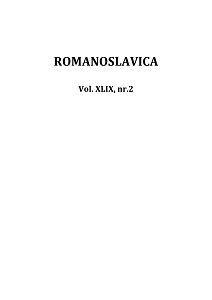Bizantyńsko-słowiańskie teksty apokryficzne i ich wpływ na rumuńską obrzędowość ludową regionu Karpat. I. Apokryfy staro-i nowotestamentowe
Byzantine-Slavic apocryphal texts and their influence on Romanian folk rituals in the Carpathian region. I. Old and New Testament Apocrypha
Author(s): Ewa KocójSubject(s): Customs / Folklore, Western Slavic Languages, 6th to 12th Centuries, Eastern Orthodoxy, Philology, Sociology of Religion
Published by: Editura Universităţii din Bucureşti
Keywords: Cyrillo-Methodian heritage; Orthodox religion; Romania; apocryphal texts; folk books; folk tradition;
Summary/Abstract: Searching for the sources of Romanian religiosity we encounter many canonical and apocryphal texts that undoubtedly contributed to the creation and formulation of specific folk beliefs. A considerable chunk of these belong to the Cyrillo-Methodian heritage that permeated Romanian lands since the 12th century, gradually gaining control over the religious representations of Romanians. This tradition influenced the form of folk representations as well as symbolism of time related to the Orthodox calendar. This paper will present the body of the most significant Byzantine-Slavonic texts considered to be apocryphal, quasi-canonical or pseudo-canonical. I will analyze the new and old testament apocrypha, hagiographic legends, romances and novels and how they influenced the beliefs and customs of the Carpathian region in Romania. In Romania they are primarily considered to be the “folk books” (cărţile populare) and treated as texts designated for the people, and writings which immensely influenced the specific representations currently present in this culture. It is worth to emphasize, however, that in the Orthodox tradition they assumed a complementary role and were treated as sacred texts, equal to the canonical ones. At the same time they indirectly represented an outstanding collection of multiculturalism in ancient heritage – the Byzantine, Turkish-Arab, Hebrew and Latin traditions – embracing the old beliefs and spreading them on new lands with the assistance of the written word. The above-mentioned works came to Romania from the Orient and Byzantium, quite often accompanying the Slavic people. Many of these books found their way to the Athos mountain, and when the first relations between the Romanian principalities and Athos monks emerged, this literature was also introduced into Wallachia and Moldavia. The presence and circulation of these texts in the cultural domain is a source of multi-lateral and (due to people’s modifications) original beliefs supporting the uniqueness of Romanian culture.
Journal: Romanoslavica
- Issue Year: XLIX/2013
- Issue No: 2
- Page Range: 97-114
- Page Count: 18
- Language: Polish

